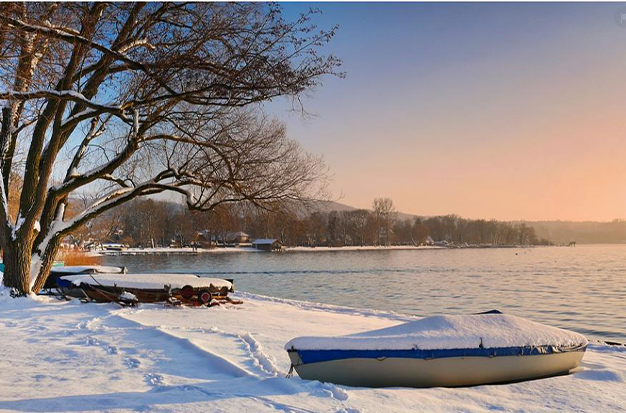How much does it cost to winterize a boat? Owning a boat is fantastic, but it also comes with significant responsibility. The cost of purchasing and maintaining your boat is high, so you should also consider properly winterizing it during the coldest part of the year. In spring, you might experience serious issues if you don’t have this protection.
The next concern is how much it will cost to winterize a boat after you have an understanding of the important safety measures you must take. The type of boat and where you are located will typically affect how much it costs to get your boat ready for the winter. Additionally, it will differ if a DIY project is planned or a professional is hired.
The Real Cost Of Winterizing A Boat
It’s true that winterizing a boat can be expensive. Finally, all that will be required for you to use it is to de-winterize it. But the cost of not properly completing the process can be much, much higher.
Lack of winterization can lead to a number of problems, including a damaged engine from the expansion of frozen fluids, mold and mildew fouling the vessel’s interior, corroded wiring and spark plugs, and even hull cracks.
It doesn’t seem like a big deal to spend money on winterizing a boat when compared to the cost of replacing an engine, hiring a mold removal team, or even possibly having your boat’s seaworthiness compromised.
The Average Cost Of Winterizing A Boat
Here is the big revelation: The average cost of winterizing a boat is about $300.
I derived that figure from my own observations, as well as from a survey of boating discussion forums, reading up on what experts have to say, and, of course, from looking at rates that were being advertised in different cities across the nation.
You might get away with paying a boat mechanic less than $100 for a smaller boat with a single outboard motor.
You should expect to pay at least $500 to $600 for a large cabin cruiser or specialty boat, such as a go-fast boat.
Now, for winter storage, there’s an additional cost, of course. Indoor boat storage can range in price from $20 per month to more than $400 to $500 per year, depending on where you live and the type of boat you own. Even though it all adds up, purchasing a new boat is still less expensive.
The Cost Of Diy Winterizing A Boat
Winterizing your boat yourself is a great way to save money for the resourceful, independent boat owner. Ironically, doing things yourself might even save you some time.
In many cases, winterizing a boat can be completed in less time than it would take to simply drive the boat to and from the marina or shop. Just be patient when finishing the procedure for the first few times. Haste creates waste and may result in an engine that is damaged.
The Cost Of Not Winterizing
You will probably incur costly damages, such as:
- Freezing water in the engine
- Rust in cylinders
- Mold development inside the boat
- Hull cracks and corrosion
You could spend a lot of money on any of those things. If you forget to lubricate the gear case, for example, you will have to pay $2,000 to $6,000 for repairs. Even more money will be spent on replacing the engine.

What Steps A Boat Must Take To Prepare For Winter?
If the temperature drops below freezing and stays there for more than 12 hours, multiple systems on boats could be damaged unless they have been winterized. Water that freezes inside of them can harm your engine, water system, water pipes, outdrives, water pumps, live well, heads, and faucets. It can be very expensive to repair or replace them.
Mechanicals
Outboard, inboard, and combined inboard/outboard (sterndrive) engines are all common on boats. In spite of their various designs, they are essentially the same. The engine requires the most care when preparing your boat for winter storage.
Frozen water that is left in an engine can cause the block and other components to crack, resulting in very expensive damage. If you don’t perform this maintenance, it could cost you thousands of dollars in repairs. The time and money spent getting your boat ready for winter could prevent that.
Change Oil
Now is a great time to change the oil in your engine because you don’t want to keep using the oil you’ve been using all season. Depending on the size of the engine in your boat, the price to change your own oil ranges from $50 to $100. An oil change for your boat will cost between $200 and $300 if you pay someone else to do it. This adds an additional $100 to $200 to the bill.
Fogging The Engine
Your engine’s interior components are safeguarded by fogging it. Each manufacturer tends to produce a unique version of this product. For specific usage instructions, consult your engine owner’s manual and the product you are using. They recommend their brand of fogging aerosol and method of application.
As your boat waits for spring, fogging applies a thin layer of oil to the engine’s interior to prevent corrosion. It is advised for use as a way to shield your engine from moisture on outboard motors, Jet Ski motors, and inboard motors.
Drain The Engine Of All Fluids
Every engine has a petcock, which is a valve that enables water to be drained from the engine. It is on the side of the engine and typically has a bronze color. The water pump’s lower hose should then be removed, and the water should completely drain.
If water is left in the engine, it could freeze, crack the engine block, and result in other problems. You can see how crucial this step is considering that even the smallest inboard or outboard engine replacement costs over $10,000.
Water System
You must drain your boat’s water holding system as well, particularly if it includes a pump, plumbing, and a kitchen and bathroom. If you leave water in it over the winter, it could burst the pipes, necessitating replacement, flood the interior of your boat, and result in damage.
Don’t forget to drain the water pump, the lines, and the water holding tank. If the head (toilet) is a self-contained unit, remove it and empty it as well after draining the water from it. The cost to drain it is zero dollars, and every water system varies slightly from boat to boat. A boatyard may charge up to $200 or more to complete this task.
Fuel System
You must add a fuel stabilizer to the fuel tanks of your boat before putting it away. By doing this, moisture accumulation in the fuel system will be avoided. You must spend between $5 and $15 to complete this maintenance task. Once more, the cost is based on the size and number of engines in your boat. Although you should budget about $250 if you hire a mechanic to complete this task. Ow!
Livewells
Make sure the water is removed from any live wells on your boat, as well as the pumps that serve them. If you leave water in the tank or the pump, it might freeze and expand, cracking the casing and breaking your pump.
If you drain live wells and their pumps yourself, the only expense is your time. However, depending on the task, labor costs at a boatyard range from $70 to $120 per hour.
Clean The Exterior And Interior Of Your Boat
Your boat should have both the exterior and interior cleaned at least once per year. Winterizing is a good time to complete this task. During this time, you can clean and polish the hull of your boat and collect any items that have been left behind. You can also sweep and mop the floors of the cabin, cockpit, and upper decks.
The gel coat of your boat can be preserved by cleaning the hull, and canvas accessories like boat covers and bimini tops can have their lifespans increased by cleaning.
The price per foot to detail a boat ranges from $10 to $50. Your boat’s size and condition will affect the price. A buffer, cleaners for the hull, interior, canvas, and labor are the expenses if you choose to do it yourself. You should only need to spend less than $100 to clean and detail your boat yourself.
Ways To Save Money While Winterizing The Boat
When winterizing your boat, you can find a few ways to cut costs, such as:
Oil changing – Oil should be changed while the engine is still warm. In this manner, the old oil can be more easily removed, and the new oil can coat the engine interior more quickly. By doing this, you’ll increase the longevity of the boat’s motor.
Remove the battery – Never leave the boat’s battery connected; always take care to store it properly. In the event that you don’t, you’ll probably have to replace it in the spring.
Marine antifreeze – A high-quality product will safeguard the piping and stop fluids from freezing. As an alternative, you can purchase RV antifreeze concentrate, which is less expensive but equally as effective.
Custom fabric cover – The hull of the boat is safeguarded from freezing temperatures by a high-quality boat cover. Find a personalized cover or reusable tarp is the best solution.
It is always preferable to complete this task alone. In addition to getting some experience, it will be less expensive. Nowadays, it is not a particularly difficult task because there are so many tutorials available.
Conclusion
It will cost much less to winterize your boat yourself than to hire a pro. To avoid incurring additional costs for harming your boat engines, we would prefer that you leave it in the hands of a professional if you are not well-versed in all the required winterizing procedures. To enhance your winterizing abilities, you can practice more.

